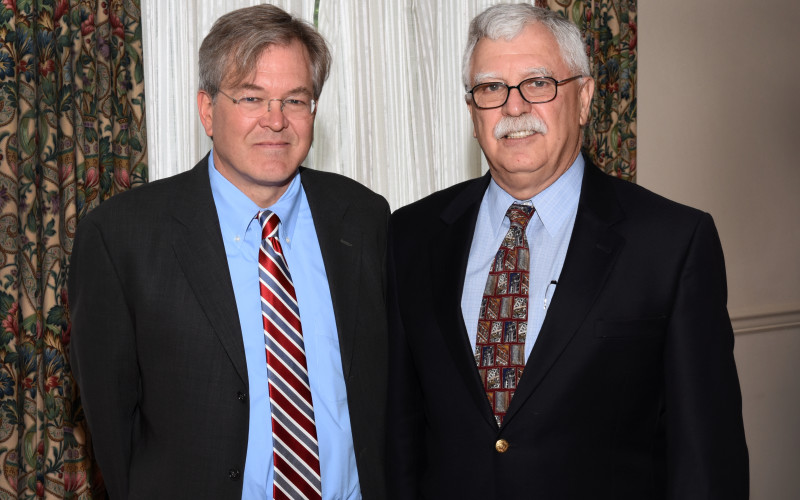Christiana Care partners with construction leaders to discuss substance abuse

Recognizing the high incidence of alcohol and drug abuse in the construction trades, Delaware contractors are exploring ways to tap Christiana Care’s expertise in fighting addiction.
“Substance abuse is endemic, but unfortunately when we identify a problem we do not have the expertise to make sure someone is on the path to getting the help they need,” said Stephen M. Mockbee, founder, chairman and former president of Bancroft Construction Company and a Christiana Care Health System trustee. “Project Engage has the capacity to help us improve the health care of our employees.”
At a meeting of 40 Delaware contractors on May 20 at the University and Whist Club in Wilmington, Mockbee joined with other representatives from the construction trades, as well as staff from Project Engage, to outline the problem faced by the industry and discuss how Project Engage could make a difference. The event was held in partnership with the Delaware Contractors Association and Associated Builders and Contractors.
They hope to form a partnership with Project Engage, a collaborative program of Christiana Care and Brandywine Counseling and Community Services, which has used peer counselors to engage with more than 3,000 patients with substance use disorder at hospital bedsides.
Since 2008, the program has shown success in helping patients engage in substance-abuse treatment. Delaware contractors believe they have employees that could benefit from consulting peer counselors with Project Engage.
Addiction is a chronic brain disorder and is not a character flaw. Addiction is in every community and is about 10 percent of every population, though more in the construction work group.
Mockbee pointed out that the incidence of substance abuse is twice as high in the construction trades as in the overall U.S. population. For example, the use of prescription medication is estimated at 22.5 percent of workers in construction and 11.7 percent for Americans as a whole. Research suggests that 17.2 percent of construction supervisors have a problem with drug use and that 12.7 percent are heavily dependent on alcohol.
Three members of the construction community gave testimony to painful and challenging issues that they experienced around addiction. The speakers were Marian Young, a co-founder of the remediation and environmental consulting firm BrightFields Inc.; Lyle Frederick, project executive at Skanska USA Building Inc.; and mechanical contractor Ralph Degli Obizzi, who has been in business in Delaware since 1969. Each spoke of the need for greater education on addiction and professional assistance in order to offer employees and family quality care.
Degli Obizzi told the story of a heavy equipment operator who fell asleep on his backhoe and was far from cooperative when asked to take a drug test. Though the employee eventually admitted he had a problem and achieved sobriety, Degli Obizzi said there were many ups and downs that he was ill-equipped to handle.
“I think with proper guidance our employee would have returned to work quicker and with less aggravation,” Degli Obizzi said. “I believe it could have been easier with the help of Project Engage.”
Terry L. Horton, M.D., FACP, chief of the Division of Addiction Medicine and medical director of Project Engage, told contractors that he understood addiction personally and professionally. The grandson of a master carpenter, Dr. Horton grew up in a Wilmington neighborhood where three close boyhood friends struggled with addiction until they eventually landed in prison. “It was all drugs, all unintended and all undiagnosed,” he said.
He explained that drug use is not merely a matter of willpower.
“Addiction is a chronic brain disorder and is not a character flaw,” said Dr. Horton, who was, before joining Christiana Care, the medical director and vice president at Phoenix House Foundation, a national leader in providing substance abuse services. “Addiction is in every community and is about 10 percent of every population, though more in the construction work group.”
Drugs hijack the brain’s motivational reward system and, over time, damage areas involved with judgment and risk decision making. “Motivational circuits are fried, and stereotypical behaviors are common,” he said. “Patients lie, they cheat, they deny and they manipulate. These are symptoms of the disease.”
But they also are miserable, and Dr. Horton has found that when substance-use disorder patients come to Christiana Care they often feel vulnerable and are reachable when engaged at the bedside by a peer counselor — someone who has walked in their shoes.
“If they are ready to change, we’ll help them transition into community-based drug treatment, walking alongside them on what feels like a shaky rope bridge, connecting them to a treatment network and everything that follows after that,” he said. “We’re about coaching, educating and supporting everyone — the patient, the family, the doctor and the nurse. That’s very much our role at Project Engage.”